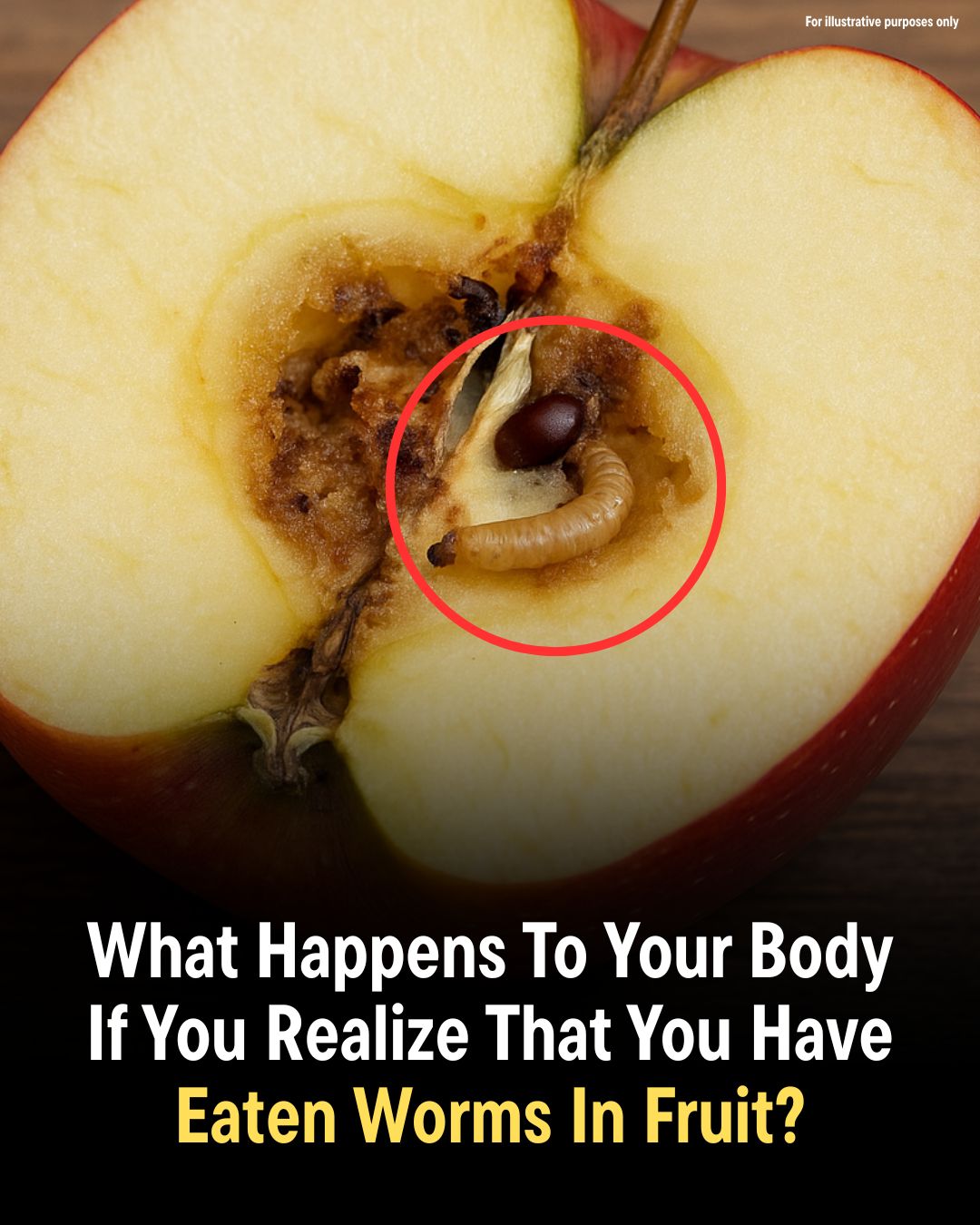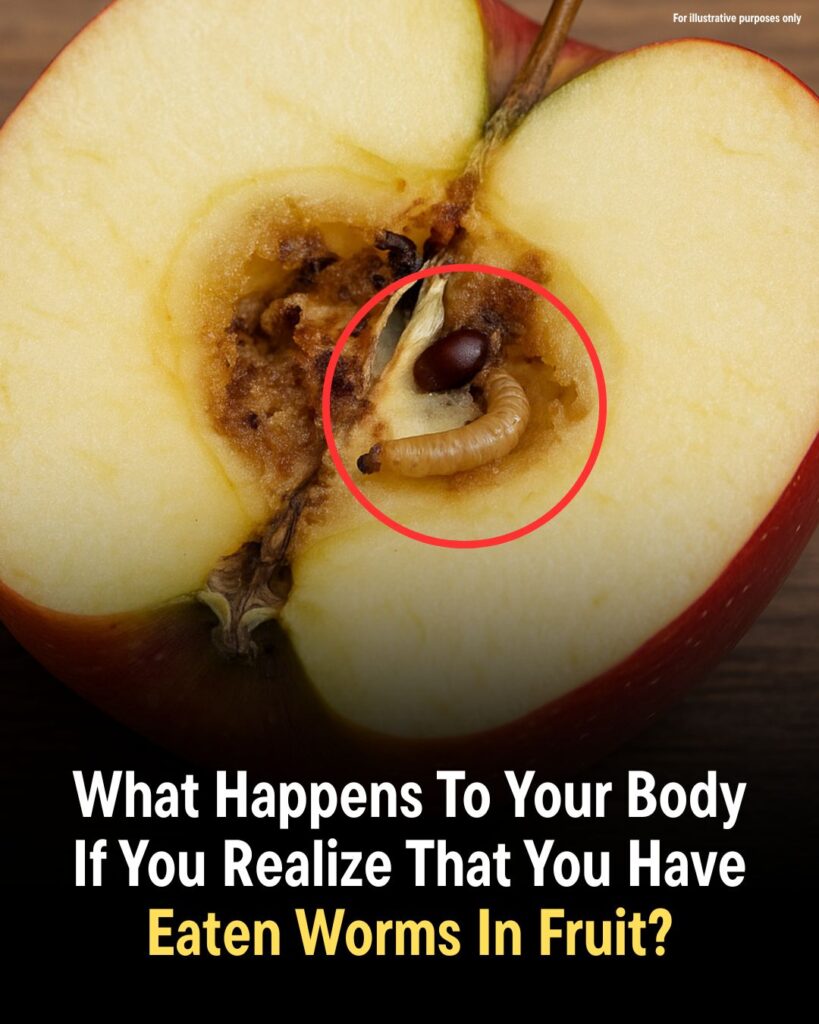You reach for that perfectly ripe apple, ready for a juicy bite, or slice into a sweet peach, only to find… an uninvited guest. A tiny, wriggling worm. Your stomach lurches, a wave of disgust washes over you, and suddenly, that delicious fruit seems utterly unappetizing. It’s an unpleasant surprise, no doubt, but here’s the reassuring truth: finding a worm in your fruit is surprisingly common, especially with organic or homegrown produce. And in most cases, it’s completely harmless!
So, before you toss that entire fruit (and maybe your appetite!) into the trash, let’s peel back the layers on what’s really going on, what you should do, and how to minimize future encounters. Your health (and your fruit basket!) will thank you. 👇
The Uninvited Guest: What’s That Wriggle (and Is It Safe?)
That “worm” you’ve found is almost certainly an insect larva – typically the offspring of fruit flies, moths (like the codling moth in apples or the Oriental fruit moth in peaches), or beetles. These tiny creatures are simply doing what nature intended: munching on their favorite food source.
Generally Harmless: While the sight might be unappealing, accidentally ingesting a small larva is highly unlikely to cause illness or harm to human health. These aren’t parasites that thrive in the human body; they’re fruit-eaters. Your stomach acid is more than capable of breaking them down.
A Sign of Nature: In many cases, finding larvae is actually a good sign! It often indicates that the fruit was grown with minimal (or no) pesticides, allowing nature to take its course. It means your fruit is truly “natural”!

Your Action Plan: What to Do RIGHT NOW!
So, you’ve spotted a wriggler. Here’s your calm, step-by-step guide:
Don’t Panic – Reassure Yourself!
Remember: it’s not dangerous. Take a deep breath. It’s a natural part of food, especially produce grown without heavy chemical intervention.
Examine the Fruit Closely:
Once you spot the larva, carefully cut the fruit open to assess the extent of the “damage.”
- Localized Damage: If the worm (or its tunnel) is confined to a small, isolated area, you can simply cut out that section. The rest of the fruit is perfectly fine to eat.
- Extensive Damage/Spoilage: If the fruit is extensively tunneled, discolored, mushy, moldy, or has an off smell, it’s best to discard the entire fruit. This isn’t because of the worm itself, but because the damage might have allowed other bacteria or mold to develop.
Remove & Dispose of the Worm (and Damaged Parts):
Carefully remove the larva and any affected fruit portions. Wrap them tightly in tissue, a paper towel, or place them in a sealed bag before disposing of them in a trash can with a lid. This prevents any larvae from surviving or spreading to other produce.
Clean Up Properly:
Hygiene is key after handling any food, especially if you’ve found pests.
- Wash Your Hands: Thoroughly wash your hands with soap and warm water.
- Clean Surfaces: Clean any knives, cutting boards, or kitchen surfaces that came into contact with the worm or the spoiled fruit using hot, soapy water.
Check Other Fruits in the Batch:
If the fruit came in a batch (e.g., a bag of apples, a box of berries, or a bunch of grapes), inspect the rest of the produce for subtle signs of infestation:
- Tiny holes or entry points (often small and dark).
- Soft, brown, or mushy spots that seem out of place.
- Any signs of movement or frass (insect droppings, which look like tiny dark specks).
- Store unaffected fruit in the refrigerator to slow down any potential development of hidden larvae.
Why Them? Understanding the “Why” Behind the Wriggle
It’s not a personal attack on your fruit! Here’s why these little guests show up:
- Nature’s Way: For organic or homegrown fruit, the absence of synthetic pesticides means insects have a natural opportunity to lay their eggs on or in the fruit. It’s part of the ecosystem!
- Life Cycle: Adult insects lay their eggs on the fruit’s surface or just beneath the skin. When the eggs hatch, the tiny larvae burrow into the fruit to feed and grow, protected from the elements.
- Ripeness Attracts: Over-ripening fruit, especially if it’s left on the plant or in a fruit bowl for too long, becomes more attractive to egg-laying insects. The softer, sweeter flesh is easier for larvae to burrow into.
- Subtle Entry Points: Sometimes, the entry hole is so tiny it’s almost invisible, making it impossible to spot an infestation until you cut the fruit open.
Beyond the Worm: Preventing Future Encounters (Your Proactive Playbook!)
While you can’t guarantee a worm-free fruit every time (especially with natural produce), you can significantly reduce the chances of future surprises!
Wash All Fruit Thoroughly:
- Running Water: Always wash all fruit under running water, even if you plan to peel it. This helps remove surface contaminants, including eggs or tiny larvae that haven’t burrowed in yet.
- Saltwater Soak (The “Worm Whisperer”): For fruits like berries, grapes, or even apples, a saltwater soak can be incredibly effective. Mix 1 tablespoon of salt per liter (about 4 cups) of water. Submerge the fruit for 5-10 minutes. The salt water often encourages any hidden pests to emerge. Rinse thoroughly afterwards.
- Vinegar Rinse: A diluted vinegar solution (1 part white vinegar to 3 parts water) can also help remove surface pests and bacteria. Soak for a few minutes, then rinse well.
Smart Storage is Key:
- Refrigerate Promptly: Store most fruits in the refrigerator. The cooler temperatures slow down spoilage and significantly inhibit the development and activity of any hidden larvae.
- Proper Airflow: Don’t overcrowd your fruit bowl or fridge drawers. Good air circulation helps prevent moisture buildup, which can encourage mold and attract pests.
- Separate & Inspect: Keep new produce separate from older produce. Inspect fruit regularly and remove any that show signs of spoilage or infestation immediately to prevent spread.
Shop Smart & Inspect at the Store:
- Firm & Unblemished: Choose fruits that are firm, free from visible damage, soft spots, or tiny holes.
- Reputable Sources: Buy from reputable grocery stores, farmer’s markets, or local farms where you trust their handling practices.
Homegrown Fruit Tips (for the Gardeners!):
- Organic Pest Control: If you grow your own fruit, consider organic pest control methods like neem oil sprays, fruit bagging (placing small bags over individual fruits as they grow), or introducing beneficial insects (like ladybugs) that prey on fruit pests.
- Timely Harvest: Regularly inspect and harvest ripe fruit. Don’t leave over-ripe or fallen fruit on the ground, as it attracts pests and encourages breeding cycles.
- Pruning: Proper pruning can improve air circulation around fruit, making it less appealing to some pests.
Be Mindful, Stay Healthy, Embrace Nature!
While discovering a worm in your fruit can be off-putting, it’s not necessarily a cause for alarm. In fact, it’s often a testament to the fruit’s natural origins and minimal pesticide use. With a few simple steps—inspect, clean, dispose properly, and practice smart prevention—you can handle the situation safely and continue enjoying fresh, delicious produce with peace of mind. It’s just nature’s way of reminding us that we’re part of a bigger, wrigglier world!
What’s your best tip for keeping fruit fresh and pest-free? Share it in the comments below! 👇
#FruitSafety #FoodHygiene #OrganicProduce #Homegrown #PestControl #KitchenTips #HealthyEating #FoodFacts #NatureIsWild #FoodTips #ViralHealth
Beta feature


